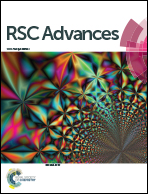Concentration gradient generator for H460 lung cancer cell sensitivity to resist the cytotoxic action of curcumin in microenvironmental pH conditions†
Abstract
We proposed and demonstrated a concentration gradient generator (CGG) to resist H460 lung cancer cells using curcumin in microenvironmental pH conditions. The CGG was designed as the integration of one-by-two and one-by-three fluidic channels to effectively generate a different concentration gradually. In cell biology, this CGG device was realized to test its operability and practicability. Therein, H460 lung cancer cells could be restrained by the injection of different curcumin concentrations. At a pH = 6.5 microenvironment, the apoptosis rate (AR) of H460 lung cancer cells was not obvious until the curcumin concentration was increased to 57.2 μg mL−1, at which the AR was 47.8%. At pH = 7.4 and 8.5 microenvironments, the ARs of the H460 lung cancer cells were 54.5% and 93.8%, respectively, at a curcumin concentration of 57.2 μg mL−1. In the range of curcumin concentration of 57.2–100 μg mL−1, the average ARs of the H460 lung cancer cells were 53.6%, 58.4%, and 98.0% for pH = 6.5, 7.4, and 8.5 microenvironments, respectively. The resistant efficiency of H460 lung cancer cells could be enhanced substantially at a pH = 8.5 microenvironmental condition. These results pave a way for the use of CGGs in cell biology application.



 Please wait while we load your content...
Please wait while we load your content...